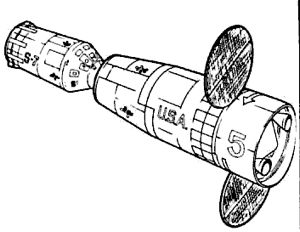
Home - Search - Browse - Alphabetic Index: 0- 1- 2- 3- 4- 5- 6- 7- 8- 9
A- B- C- D- E- F- G- H- I- J- K- L- M- N- O- P- Q- R- S- T- U- V- W- X- Y- Z
MORL Mars Flyby
 MORL Mars Flyby Credit: NASA |
Status: Study 1965. Gross mass: 360,000 kg (790,000 lb). Height: 76.00 m (249.00 ft). Diameter: 6.70 m (21.90 ft).
It differed from the contemporary NASA in-house design in using the Douglas Manned Orbiting Research Laboratory as the basis for the habitation module.
Four launches of a stretched version of the Saturn V were required for the expedition. The first three launches put three fully-fuelled S-IVB stages into orbit, which were docked in series. This was followed by launch of the 90 metric ton Mars flyby spacecraft, consisting, from fore to aft, of an Apollo command module with a crew of three, a retro module used to brake the command module prior to re-entry at the end of the mission, and a modified Manned Orbiting Research Laboratory, 6.55 m diameter x 12.80 m long.
After 30 days of checkout, the mission was launched toward Mars. Each S-IV stage fires, one after the other, to put the spacecraft on a trans-Mars trajectory. After separation of the last stage, the crew separate the CRM from the MORL, transpose, and dock with the MORL in typical Apollo fashion. They then enter the MORL for the mission. The MORL was equipped with a single-person centrifuge to provide artificial-G conditioning to the crew during the long zero-G flight.
The three-member crew fly within 5000 km of Mars, releasing robotic probes and landers to explore the planet. After a 655 day flight, the crew entered the command module, and separate from the MORL. The retro module fired to slow the approach speed to one within the capabilities of the command module. The usual Apollo-type re-entry and splashdown occur, with recovery by a US aircraft carrier.
In comparison to NASA's concept, the Douglas approach required no refueling operations in low earth orbit, and required only four launches of an improved Saturn V as opposed to six launches of a standard Saturn V. From Douglas' point of view, it also had the advantage that all of the hardware (MORL, S-IVB stages, retro module) except the Apollo command module would be Douglas-provided. It had the disadvantage of requiring development of planned but not in-being hardware (MORL, upgraded Saturn V).
MORL Mars Flyby Mission Summary:
- Summary: Manned Mars flyby using Apollo hardware for earliest possible mission (mid-1970's)
- Propulsion: LOX/LH2
- Braking at Mars: flyby
- Mission Type: Crocco
- Split or All-Up: all up
- ISRU: flyby
- Launch Year: 1973
- Crew: 3
- Outbound time-days: 125
- Mars Stay Time-days: 0
- Return Time-days: 530
- Total Mission Time-days: 655
- Total Payload Required in Low Earth Orbit-metric tons: 360
- Mass per crew-metric tons: 120
- Launch Vehicle Payload to LEO-metric tons: 137
- Number of Launches Required to Assemble Payload in Low Earth Orbit: 4
- Launch Vehicle: Saturn MLV-V-1
Crew Size: 3.
Family: Mars Expeditions, Mars flyby. Country: USA. Launch Vehicles: Mars tactical rocket, Saturn V. Agency: Douglas.
Back to top of page
Home - Search - Browse - Alphabetic Index: 0- 1- 2- 3- 4- 5- 6- 7- 8- 9
A- B- C- D- E- F- G- H- I- J- K- L- M- N- O- P- Q- R- S- T- U- V- W- X- Y- Z
© 1997-2019 Mark Wade - Contact
© / Conditions for Use